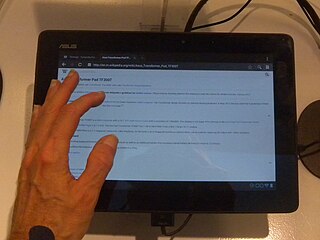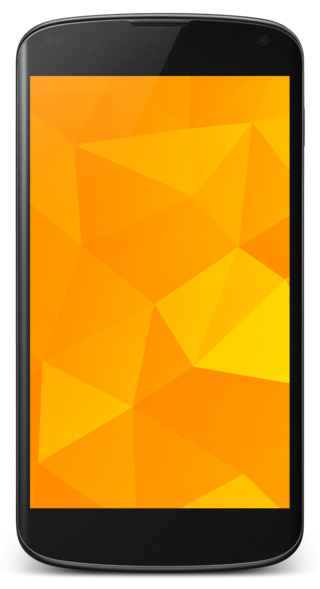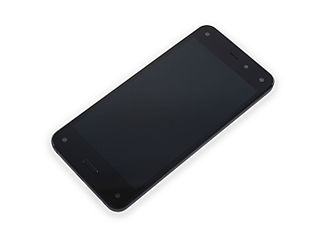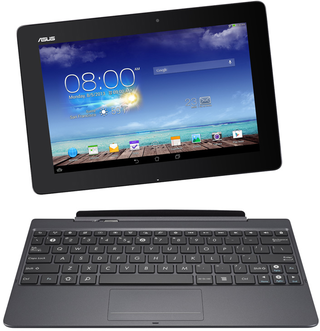
A tablet computer, commonly shortened to tablet, is a mobile device, typically with a mobile operating system and touchscreen display processing circuitry, and a rechargeable battery in a single, thin and flat package. Tablets, being computers, have similar capabilities, but lack some input/output (I/O) abilities that others have. Modern tablets largely resemble modern smartphones, the only differences being that tablets are relatively larger than smartphones, with screens 7 inches (18 cm) or larger, measured diagonally, and may not support access to a cellular network. Unlike laptops, tablets usually run mobile operating systems, alongside smartphones.

Asus Eee is a family of products by AsusTek Computer Inc. The product family began with the release of the Eee PC subnotebook in 2007; since then, the product family has diversified into a number of PC form factors. According to the company, the name Eee derives from "the three Es," an abbreviation of its advertising slogan for the device: "Easy to learn, Easy to work, Easy to play".
This is a list of tablet computers, grouped by intended audience and form factor.
Google Nexus is a discontinued line of consumer electronic devices that run the Android operating system. Google managed the design, development, marketing, and support of these devices, but some development and all manufacturing were carried out by partnering with original equipment manufacturers (OEMs). Alongside the main smartphone products, the line also included tablet computers and streaming media players; the Nexus started out in January 2010 and reached its end in October 2016, replaced by Google Pixel.

The Amazon Fire, formerly called the Kindle Fire, is a line of tablet computers developed by Amazon. Built with Quanta Computer, the Kindle Fire was first released in November 2011, featuring a color 7-inch multi-touch display with IPS technology and running on Fire OS, an Android-based operating system. The Kindle Fire HD followed in September 2012, and the Kindle Fire HDX in September 2013. In September 2014, when the fourth generation was introduced, the name "Kindle" was dropped. In later generations, the Fire tablet is also able to convert into a Smart speaker turning on the "Show Mode" options, which the primary interaction will be by voice command through Alexa.

The Asus Eee Pad Transformer TF201 or Asus Eee Pad Transformer Prime is a 2-in-1 detachable tablet from the Asus Transformer Pad series. It is the world's first Android tablet computer with a quad-core processor, and a successor to the dual-core Asus Eee Pad Transformer. It runs Android 4.1. The Transformer Prime was announced by Asus on 9 November 2011. It was released in Taiwan on 1 December 2011, and in Canada and the United States during the week of 19 December 2011.

The Asus Transformer Pad TF300T is a 2-in-1 detachable tablet from the Asus Transformer Pad series. It runs Android, has a quad-core processor, and a successor to Asus Eee Pad Transformer Prime. The Transformer design includes an optional docking keyboard. The Asus Transformer Pad TF300T was released on the market in the U.S. and Europe in May 2012.
Atom is a system on a chip (SoC) platform designed for smartphones and tablet computers, launched by Intel in 2012. It is a continuation of the partnership announced by Intel and Google on September 13, 2011 to provide support for the Android operating system on Intel x86 processors. This range competes with existing SoCs developed for the smartphone and tablet market from companies such as Texas Instruments, Nvidia, Qualcomm and Samsung. Unlike these companies, which use ARM-based CPUs designed from the beginning to consume very low power, Intel has adapted the x86-based Intel Atom line of CPU developed for low power usage in netbooks, to even lower power usage.

Asus PadFone is a smartphone manufactured by Asus and released in April 2012. The phone is marketed with companion tablet dock and keyboard dock accessories intended to improve functionality and battery life. It fits into a 10-inch tablet dock. It is not the same as the Asus PadFone mini 4.3, revealed by Asus in December 2013 since that operates on Android 4.3 Jelly Bean and is skinned with the Asus' ZenUI.

The first-generation Nexus 7 is a mini tablet computer co-developed by Google and Asus that runs the Android operating system. It is the first tablet in the Google Nexus series of Android consumer devices marketed by Google and built by an original equipment manufacturer partner. The Nexus 7 features a 7.0-inch (180 mm) display, an Nvidia Tegra 3 quad-core chip, 1 GB of RAM, Wi-Fi and NFC connectivity, and 8, 16 or 32 GB of storage. The tablet was the first device to ship with version 4.1 of Android, nicknamed "Jelly Bean". By emphasizing the integration of the Google Play multimedia store with Android 4.1, Google intended to market the Nexus 7 as an entertainment device and a platform for consuming e-books, television shows, films, games, and music.
The following is a comparison of high-definition smartphone displays, containing information about their specific screen technology, resolution, size and pixel density. It is divided into three categories, containing smartphones with 720p, 1080p and 1440p displays.

The Nexus 4 is an Android smartphone co-developed by Google and LG Electronics. It is the fourth smartphone in the Google Nexus product family, unveiled on October 29, 2012, and released on November 13, 2012, and succeeded the Samsung-manufactured Galaxy Nexus. As with other Nexus devices, the Nexus 4 was sold unlocked through Google Play, but was also retailed by wireless carriers.

The Nexus 10 is a tablet computer co-developed by Google and Samsung Electronics that runs the Android operating system. It is the second tablet in the Google Nexus series, a family of Android consumer devices marketed by Google and built by an OEM partner. Following the success of the 7-inch Nexus 7, the first Google Nexus tablet, the Nexus 10 was released with a 10.1-inch, 2560×1600 pixel display, which was the world's highest resolution tablet display at the time of its release. The Nexus 10 was announced on October 29, 2012, and became available on November 13, 2012.

Asus Fonepad is a series of 6", 7" and 8" tablet computers with mobile cellular telephony capability developed by ASUS. The first model, the Fonepad ME371MG, was launched on April 24, 2013 in India, and April 26 in UK. Six months later, in September 2013, the Asus Fonepad 7 2014 Edition was launched, followed by the Fonepad 8, and an upgraded 7, in June 2014. On August 26, 2014, Asus launched the Asus Fonepad 7 2014 edition (FE7530CXG), which is a 3G phone calling tablet with an Intel Atom Z3560 processor, 1GB RAM, a 7-inch 1280x800 screen, and Android 4.1.2 Jelly Bean.

The second-generation Nexus 7, also commonly referred to as the Nexus 7 (2013), is a mini tablet computer co-developed by Google and Asus that runs the Android operating system. It is the second of three tablets in the Google Nexus tablet series, the Nexus family including both phones and tablets running essentially stock Android which were originally marketed for developer testing but later marketed by Google to consumers as well, all of which were built by various original equipment manufacturer partners. Following the success of the original Nexus 7, this second generation of the device was released on July 26, 2013, four days earlier than the originally scheduled date due to early releases from various retailers. The tablet was the first device to ship with Android 4.3.
Asus Memo Pad™ 8 is a middle-range Android tablet computer manufactured by Taiwanese corporation Asus. The tablet was announced in September 2013 and is expected to go on sale before the end of the 2013 holiday season. The device runs on Android 4.2.
ASUS MeMO Pad HD 7 is a low-end low priced budget Android tablet manufactured by Taiwanese corporation Asus. The tablet was announced in June and released in July 2013. The device runs the operating system Android 4.2. The specifications include a 7-inch IPS LED display, 1.2 GHz quad-core ARM Cortex-A7 processor, 1 GB of RAM, a storage of 8 GB or 16 GB, and 5 MP rear camera.

The Fire Phone is a discontinued 3D-enabled smartphone developed by Amazon and manufactured by Foxconn. It was announced on June 18, 2014, and marked Amazon's first foray into the smartphone market, following the success of the Kindle Fire. It was available for pre-order on the day it was announced. In the United States, it launched as an AT&T exclusive on July 25.

The Asus Transformer Pad TF701T is an Android tablet computer made by Asus, successor to the Asus Transformer Pad Infinity. The Transformer design includes a docking keyboard. The Asus Transformer Pad TF701T was released in the UK in October 2013 and in the U.S. in November 2013.













